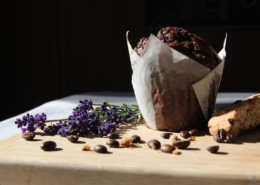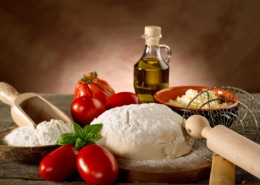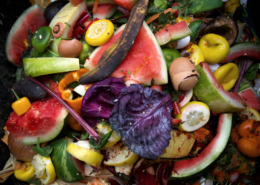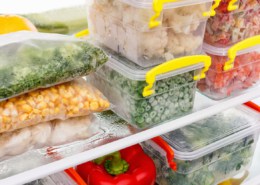Moldy Cheese: How to Prevent, Fix, and When to Toss It Out
Call me picky, but I prefer my greens to be those of the garden variety, not something growing on my cheese. Moldy cheese can be quite disgusting but tossing it in the trash is not your only or even the best option.
Don’t you just hate when this happens: You buy a block of cheese and before you can use it up it turns into something that looks more like a science fair project than a tasty dairy product.
I’ll admit it. Back in my carefree spendthrift days, I’d toss the cheese in the garbage when it turned moldy—oblivious to the fact that I might as well be tossing dollar bills.
True, we could opt for buying just a few slices at a time from the deli counter, but that’s too expensive. And unnecessary. I can save more than $2 a pound off the best price at the supermarket if I buy in bulk from a discount warehouse like Sam’s Club or Costco. And that presents a storage challenge.
Ounce of prevention
Whoever said, “An ounce of prevention is worth a pound of cure,” must have been a deli owner. Think about it. With all that cheese in those cases, have you ever seen one growing green mold that looks like we can grow in our refrigerators? Never.
All I know about the proper care and handling of cheese I learned from one such person. That kind deli owner introduced me to the two archenemies of cheese: bacteria and air.
Air
Limit exposure to air and you can greatly extend the useful life of any type of cheese. For hard cheeses like cheddar or Monterey Jack, make sure that you keep them tightly wrapped with plastic wrap.
Bacteria
We know that it takes bacteria to make cheese in the first place, but that is much different than the kind of bacteria on your hands. My expert witness was insistent that touching the cheese with bare hands encourages mold to develop.
Rule 1
The first rule of mold prevention: Each time you open it, reseal just as tightly and completely as possible. That takes care of the air problem.
Rule 2
The second rule of mold prevention: Don’t touch the cheese! Even when you wash your hands well, some amount of bacteria remains and while not at all harmful to you or the cheese, that’s what gets that green thing going.
Either wear food preparation gloves or make sure the plastic is always creating a barrier between your hands and the portion of the cheese that’s going back into the refrigerator.
Pro Tip
Here is a bonus tip that will at least double the shelf life of cottage cheese. Once opened, stir in a pinch of salt. That retards the growth of bacteria without affecting the taste. Apply the lid tightly to the unused portion and then store it upside down in the refrigerator. This will seal out air.
Pound of cure
For a cheese that has already turned, there are remedies. You can fix that green, moldy cheese.
Vinegar
You can actually wipe the mold away with a clean cloth you’ve dipped into white vinegar. Not the most pleasant job, it does work to save the cheese.
Cut it out
Another useful technique is to simply cut away the moldy parts. Once all the green is gone, treat this as you would a new block of cheese by following the two rules above.
Pro Tip
If you’re not going to use it right away, store your cheese in the freezer. Really, you can! Soft cheeses like Brie and Camembert stay usable for up to a year when frozen. Hard cheeses will last twice that long if tightly wrapped before freezing. Just know that once frozen, you will not be able to slice hard cheeses. When you try to do that, you’ll find the thawed hard cheese will crumble. But that’s OK if you were planning to shred or crumble it anyway.
FAQs
Do you have to toss all moldy cheese?
According to Liz Thorpe, cheese expert and author of The Book of Cheese, maybe not. If the mold is on the cut surface, just take a knife and scrape it off. She adds that you can also use a cheese plane to peel off a thin layer. The cheese underneath is fine. You just trim it off. That’s it.
What about cheese that I prepared for a cheese plate. It's been out for hours.
In general, says Liz, you can save the cheese and you can put it back into the fridge. Just do not touch it with your fingers. (See Rule 2 above.) There are a few exceptions: 1. If that cheese was next to say fish or meat, toss it due to the possibility of cross-contamination. 2. If it’s mozzarella or burrata (very soft cheese) that’s been sitting out at room temperature, give it the boot. 3. If it’s sheeps milk cheese, which because of the extra fat has turned “sweaty,” that does not mean it is bad. Just pat it off and then you can wrap it and keep it.















Frozen cheese can come back to nearly normal slicing. I found out by accident years ago. I accidentally left my frozen cheese on the counter until it became room temperature! I popped it into the refrigerator as soon as I noticed! When I took it out to use it, no more crumbles! It sliced perfectly!
Amazing … gotta’ try this, Sky! Thanks
fifty years ago i worked in a gourmet cheese shop. the reason you don’t see mold in a shop’s cases is usually because every morning we went on a ‘mold patrol’ to find and fix moldy cheese. anytime cheese was unwrapped to cut off mold or to cut a portion for a customer, it was re-wrapped in new plastic and was absolutely airtight. every time a knife was used to cut cheese, it was washed before using it again. hands were always washed. our store did not slice cheese because that was the fastest way to dry it out. to this day, i follow those directions and never have more than a spot or two of mold, that i quickly take care of before it gets worse.
When I slice some off of a block of cheddar, I tightly wrap the sealed end with cling wrap, then put the whole thing in a vacuum seal bag, and vacuum seal it. I have gone back two months later, and there was no mold on the cheese. This was in a refrigerator.
I have been experimenting for years, wrapping with paper towel before putting cheese in old bread bags or zip lock bags helps prevent mold as it absorbs excess moisture, change the paper towel as it gets moist with storage.
Lately I have been trying heat treatment to prevent mold, quickly passing a butane torch over the cheese surfaces will kill any mold present, a theory I came up with after getting a gift of food grade wax for coating cheese for ageing. If the hot wax will kill all surface mold and allow long term ageing then a quick once over with a light flame will help too.
A heat gun like you use for crafts and shop work would probably work well and less likely to affect the taste as unburned gas like propane will make food tatse weird.
I have also cold smoked cheese that when vacuum sealed has lasted over a year in the fridge.
We buy the large packages of cheese slices at Costco, I always freeze one half as we never finish the whole pack before mold sets in, the frozen slices are crumbly, but will seperate easy enough with a small knife as they are packaged with waz paper between the slices.
Thank you so much for say. “Cut it out”!
So many people when they see the mold , they throw it away . What a waste!
I was raised to grate my own cheese fresh and wrap with plastic wrap tightly. And if there is any mold. Just cut it away. Not throw it away!
But I never heard to not touch the cheese with you bare hands. We never use gloves. But I will start using Food grade prep gloves.
Thank you again!
Hard cheese keeps better when wrapped in parchment paper than with plastic. You can then put the parchment wrapped cheese in a ziplock.
My favorite reason to freeze cheese to crumble it! We buy a large block of feta cheese and slice it into smaller slices before putting it in food saver bags. When I want crumbled feta for a salad or omelet I remove on of these slices and crumble it with a fork. It’s much, much, cheaper than the tubs of feta cheese and the freezing first makes it easy to crumble.